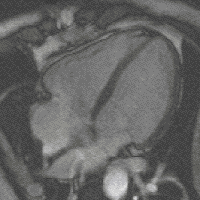Steady-state free precession imaging
Steady-State Free Precession Imaging (SSFP) is a magnetic resonance imaging (MRI) technique that is utilized to generate high-contrast images by using a steady state of magnetization. This method is particularly effective in areas where fast imaging is required, such as in cardiac or abdominal MRI. SSFP sequences are known for their high signal-to-noise ratio (SNR) and efficiency in acquiring images, making them a preferred choice for various clinical applications.
Overview[edit | edit source]
In MRI, the concept of steady state refers to the condition where the net magnetization vector (NMV) reaches a constant magnitude and direction over consecutive cycles of radiofrequency (RF) excitation and relaxation. SSFP imaging takes advantage of this steady state to produce images with high SNR and contrast in a relatively short scanning time. The technique is characterized by its use of rapid repetition of RF pulses and gradient echoes, which helps in maintaining a steady state of transverse magnetization.
Principles[edit | edit source]
The basic principle behind SSFP imaging involves the continuous application of RF pulses at a specific repetition time (TR) that is short enough to ensure that the transverse magnetization does not fully decay between pulses. This creates a steady state of magnetization that is a combination of both longitudinal and transverse magnetization components. The frequency of the RF pulses is carefully chosen to match the precession frequency of the hydrogen nuclei in the magnetic field, which maximizes the efficiency of energy transfer and enhances the signal intensity.
Applications[edit | edit source]
SSFP imaging is widely used in various clinical applications due to its versatility and efficiency. Some of the common applications include:
- Cardiac MRI: SSFP sequences are ideal for cardiac imaging because of their ability to produce high-contrast images of the heart and blood vessels quickly, which is crucial for capturing the heart in motion. - Abdominal MRI: The fast imaging capability of SSFP is beneficial for abdominal imaging, where patient motion can often degrade image quality. - Angiography: SSFP sequences can be used to generate bright-blood angiography images without the need for contrast agents, making it a safer option for patients with kidney issues. - Functional MRI (fMRI): The high SNR of SSFP imaging is advantageous for fMRI studies, where detecting small changes in blood flow is essential.
Advantages and Disadvantages[edit | edit source]
SSFP imaging offers several advantages, including high SNR, fast imaging times, and the ability to produce high-contrast images without the need for contrast agents. However, there are also some disadvantages, such as susceptibility to artifacts from off-resonance effects and field inhomogeneities. These artifacts can sometimes obscure important anatomical details and reduce the overall image quality.
Conclusion[edit | edit source]
Steady-State Free Precession Imaging represents a significant advancement in MRI technology, offering fast, efficient, and high-quality imaging capabilities. Its wide range of applications and advantages make it a valuable tool in the field of medical imaging. However, like all imaging techniques, it is important to understand its limitations and potential for artifacts to ensure optimal image quality and diagnostic accuracy.
Navigation: Wellness - Encyclopedia - Health topics - Disease Index - Drugs - World Directory - Gray's Anatomy - Keto diet - Recipes
Search WikiMD
Ad.Tired of being Overweight? Try W8MD's physician weight loss program.
Semaglutide (Ozempic / Wegovy and Tirzepatide (Mounjaro / Zepbound) available.
Advertise on WikiMD
WikiMD is not a substitute for professional medical advice. See full disclaimer.
Credits:Most images are courtesy of Wikimedia commons, and templates Wikipedia, licensed under CC BY SA or similar.Contributors: Prab R. Tumpati, MD

